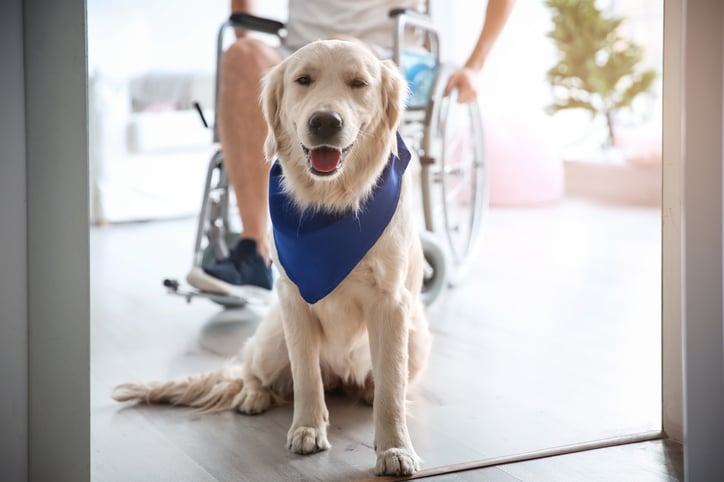6 Ways a Service Dog Can Help a Quadriplegic Be More Independent
Everyone loves a service animal. We’ve discussed the importance of service dogs before on SpinalCord.com. We know — just like all of you — how much a service dog or even a mobility assistance dog can truly transform a person's life. For those with quadriplegia (tetraplegia), a service dog can be especially life-changing. Being able to do anything again without needing help from another person after a spinal cord injury (SCI) is a monumental thing.

When searching for the perfect wheelchair service dog as a quadriplegic, first make a list of the tasks you need the most help with. For more physical tasks, consider a larger, sturdier dog. If you need help with less intense tasks in more confined spaces, a medium-sized service dog may do just fine.
Just know that a service dog can help with more tasks than you realize, especially someone with little to no arm movement. Having a service animal can make the difference between needing a caregiver 24/7 and being able to be alone a little bit each day. To see what we mean, read on for six amazing service dog tasks that can help a quadriplegic live a more independent life.
1. Answer the Door (By Pulling, Using a Tug)
When the pizza guy comes, there's nothing more awkward than telling him to “just open the door.” With a service dog, you no longer have to. Instead, you can have a rope on the door handle that your service dog can pull (with their mouth) to open the door whenever you need. For more tech-advanced houses, you can install a push button that the dog can learn to hit as well.
2. Call 911 (Via a Dog-Friendly Phone)
It's never fun to think about, but if there's a serious emergency such as falling out of your wheelchair, becoming unconscious, falling out of your bed, etc, you can train your service dog to dial 911. You can also ensure that your service dog, if coming from a nonprofit, knows this skill.
They’re able to dial 911 in two different ways. The old school way is using a landline phone with a big exposed big button pad and having it rigged so that dialing the number “9” over and over again would dial 911. The dog would be trained to hit the button pad continuously and that would eventually do the trick. Of course, your dog can't speak, but just a phone call is enough to get them to come to your house.
The new way a service dog can call for 911 is using an iPad in a much the similar fashion. Note: You will need to keep the iPad and/or landline phone in locations where the dog can reach them. There are no reports of a dog being able to use a cell phone, as the screens are too small.
3. Assist with Position Changes (Laying to Sitting, Rolling)
A task best reserved for larger dogs, a service dog can help with much-needed position changes in bed, or they can even help you sit up if you fall/slump over in your wheelchair (they will need something to tug on, such as your shirt). A service dog can even help you turn in bed by pressing their body up against you and using the right commands.
This particular task may seem dangerous for those with no arm movement and are alone in bed, but for those with low-level quadriplegia, this would be a safe and much-needed thing to have help with in bed. No longer would you need to worry about someone turning you, or just giving up and risking damage to your skin.
4. Carry Grocery Bags
For many with limited arm movement — or no arm movement whatsoever — shopping alone can be a precarious task. However, having a service dog with you can make it a more stress-free experience. Not only can a service dog take things off the shelf and put them on your lap, they can carry your bags either by mouth or by having the cashier put them on your dog's service animal vest.
While this is not something you want to have your dog do for long distances, having bag-carrying help is nice when rolling from the store and to the van or bus stop, or back home (but please, make sure they’re only carrying light bag contents). When you arrive home, your service dog also can put your groceries into the fridge.
5. Hit an Elevator Button
For those who can’t move their arms, one of the most annoying things you can't do anymore is hit an elevator button when you're out and about. You always need to have someone with you in the elevator essentially. But, with a service dog, this is no longer the case.
If the elevator floor is slippery, make sure to steady them (either with an arm or your wheelchair), and then say the command. They will jump up on their hind legs and press the elevator buttons with their paws until (hopefully) the right button is pressed.
6. Push Paralyzed Limbs Back in Place
Spasms can be very strong at times, making our legs flail, and for those with high-level quadriplegia, arms can spasm, too. While most of the time your limbs are likely secured with straps, there may be a time where your arm or leg ends up off of your wheelchair, hanging, and you will need help getting it back in place.
This is where your amazing service dog can come in to save the day and with a gentle mouth, they can literally grab your ankle or wrist and put it back where it needs to, on your foot plate or armrest. Yes, we were rather impressed with this task as well.
Quadriplegic readers: How has a service animal helped you be more independent? Be sure to share your thoughts and experiences in the comments below.
Stay Updated on Advancements On Traumatic Brain &
Spinal Cord Injuries
About the Author





